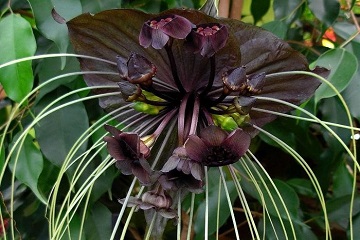Students of IPB Cultivated the Black Bat Plants as Anti-cancer

Black Bat Plant (Tacca Chantrieri Andre) was one of the most popular commodities in the world horticulture market as the ornamental plant. The crown of the maroon-black colored flower gave a unique view resembling a bat. This rare herbaceous plant grew spread in Asia, especially those with the tropical rain forest. Since old time, Chinese and Thai communities had used the rhizomes of this plant as one of the traditional remedies. The contents of the chantriolida, the evelynin, and the taccalonolida were commonly used as one of the cancer healing therapy, because it was cytotoxic (toxic to a cell) to the cancer cells.
Interested in the potential of the black bat plants moved a group of the students of Faculty of Agriculture, Bogor Agricultural University (Faperta of IPB) consisting of Rahayu Ning Janati, Rezky Yuanikha Nur Sushanty, Nikko Rizky Ajisyahputra, and Rizkiya Hani to participate in the Student Creativity Program for Research (PKM-P) 2017. The research which was carried was the conservation of in vitro black bat as the producer of the anti-cancer substance.
The black bat plants were one of the rare herbaceous plants. This annual plant was grown clumping, the habitat in the forest, the valley and along the river that had a height of 200-1300 mdpl and were widespread in Assam to Indo-China and Malaysia Peninsula. In general, this plant was cultivated by using the seeds and the stem cuttings, but until now it was very difficult to obtain the seeds. Besides due to the scarcity of the seeds, it was also the low growth power in making this plant very difficult to cultivate.
The research done in the Laboratory of Tissue Culture, Department of Agronomy and Horticulture of IPB, cultivated the black bat plants supplied from Kalimantan with the tissue culture method. The tissue culture itself was a method of isolating parts of the plant grown with the aseptic conditions, so that the plants could grow to be complete again. In this research, it was used old and young seeds for the experiment 1 and used the black bat leaf pieces for the experiments with the aid of the growth regulator of the auxin and the cytokine. Until finally it was done the analysis of the anti-cancer compound.
“Our group conducts in vitro culture cultivation, because it can produce the plant propagation from the plants in a limited and with a fast time,” explained Rahayu Ning Janati as the Chairman of PKMP Team.
“The black bat plants have lots of benefits, in addition to having the anti-cancer compound. The rhizome presented in this plant can be used as the vegetable pesticide. Other than that, also according to the research from Yokosuka and Mimaki, the extract of the rhizome has the secondary metabolite that one of them is saponin spirostanol which is known to be toxic to the human leukimia cells,” she added.
The group that shared the same scientific field expected that the research that they did besides they could produce the black bat seeds, they also hoped that the ornamental plant could be one alternative raw material of the anti-cancer drug. (GG/ris)



